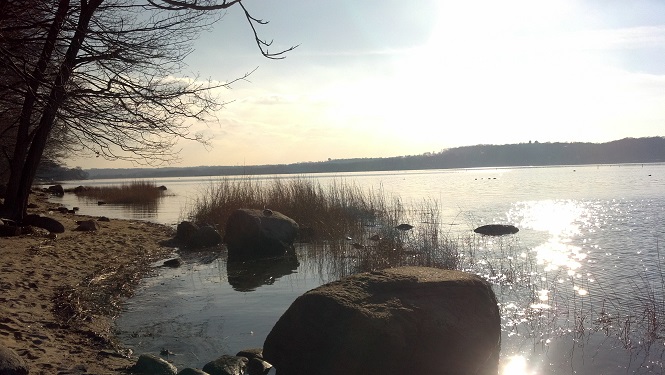The Indian Archaeology of Long Island
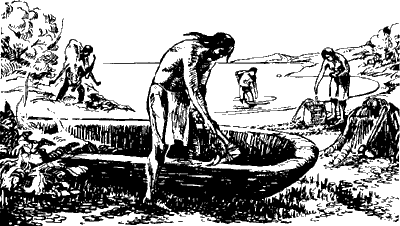
The first people on Long Island were American Indians. They may have arrived as early as twelve thousand years ago.
They were still here when Verrazano sailed into New York Harbor in 1524. The prehistoric Indians of Long Island left no written records.
Except at the dawn of historical times, we do not know the names of the Indian tribes or the languages which they spoke. The information
here is based mostly on archaeological studies. It shows that the way of life practiced by the Indians changed slowly over a very long period of time.
These changes were brought about by the periodic migration of new peoples and the introduction of new ideas to the Island, changes in the environment in
which the Indians lived, and by their ingenuity in adapting their way of life to the natural world around them.
One way to understand the story of prehistoric man on Long Island is to divide it up into "stages", each one of which characterizes a style or pattern
of Indian life based mostly on our knowledge of their foods, weapons and tools. These stages are the Paleo-Indian or Big Game Hunting Stage,
the Archaic or Hunting and Gathering Stage, the Transitional Stage, and the Woodland or Agricultural Stage. Before proceeding, it is important to understand that the Indians did not think in terms of stages, and that these stages do not refer to specific Indian tribes or linguistic groups; they are merely devices to help us understand the facts of prehistory.
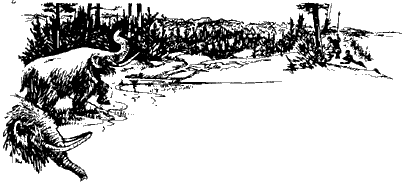

The Paleo-Indian or Big Game Hunting Stage
This stage must be viewed in the context of northeastern United States because only scanty evidence of it has been found on Long Island.
The scene for the movement of Indians into the Northeast was slowly set with retreat of the last blanket of Pleistocene glacial ice from the area.
The newly freed land was gradually populated with plant and animal life. Dense coniferous forests covered much of the Northeast. The
climate was cool and moist. By 10,500 B.C., man could have occupied southern New York. Radiocarbon dates show that he was in the province of
Nova Scotia, Canada by about 8,635 B.C.
The geographic distribution of finds of the Paleo-Indian's most characteristic artifact, the fluted spearpoint, indicates that the Indians
moved into the Northeast along major river systems such as the Allegheny, Susquehanna and Delaware. They probably also moved northward along
the Atlantic coast, but any evidence for this has long since been covered by the rising ocean waters.
Studies of the Paleo-Indian sites on the High Plains of Western United States has shown that these people lived by hunting big game animals
such as the mammoth and archaic forms of bison. It is probable that a similar elephant-like animal, the mastodon, was present in the Northeast
when the Indians first entered the area. Many archaeologists suspect that the first Indians in the Northeast were hunters who lived in small bands
and followed the movements of such animals as the mastodon, mammoth, caribou, elk, and deer. The presence of fluted points, knives and hide scrapers,
tools essential to a hunting economy, support this hypothesis. Though a piece of caribou bone, radiocarbon dated at 10,580 B.C. was recently discovered in the
same soil layer as the fluted point in a cave in Orange County, New York, no Paleo-Indian artifacts have ever been found in association with mastodon
or mammoth bones in the Northeast.
A Paleo-Indian site has yet to be discovered on Long Island, although there have been scattered surface finds of fluted points. Fluted points are more
numerous on Staten Island, and one site has been discovered there. A few mastodon finds have been made in New York City.
The Paleo-Indian way of life gradually disappeared perhaps about 7,000 B.C. The mammoth, mastodon, and many other late Pleistocene animals became extinct.
The Paleo-Indians may have hunted these animals to extinction. A changing environment that featured a warmer, more arid climate, and the gradual disappearance
of the great coniferous forests may also have spelled doom for the animals unable to adapt to new environmental conditions. Evidence of the Paleo-Indian
population, apparently never very large, disappears from the archaeological record. Remnant groups of these big game hunters were probably absorbed
by new Indian groups moving into the area and carrying a culture or way of life more suited to environmental conditions.
The Archaic or Hunting and Gathering Stage
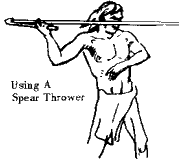
The earliest evidence for the Archaic Stage in Southern New York dates from about 4,600 B.C. There are numerous archaic camp sites on Long Island, though
few of them seem to date much before 2,000 B.C. The study of fossil plant pollen extracted from bog and marsh deposits indicate that the climate was
warm and dry. The dominant forest trees were broad-leaved hardwoods, such as oak, hickory and chestnut. The nuts from these trees, as well as the forest
undergrowth, provided ample food for a vast population of deer and turkey.
Archaic sites on Long Island are typically found along the edges of extant or formal tidal bays and streams, though some inland stations are also known.
These sites are fairly small, suggesting resident bands of fifty people or less. The food remains found in the site deposits show that the Indians
exploited a wide variety of food sources. Shellfish valves are the most characteristic feature of the coastal Archaic sites. Soft and hard clams,
oysters and scallops were gathered and steamed in pits heated by burning coals or hot stones. Thousands of fragmentary deer bones indicate that this was the animal
most commonly hunted. The meat was eaten, and the bones broken open to extract the sweet and nutritious marrow. Bird bones and fragments of box turtle shells
are also commonly found. One site has yielded a few fish bones and some notched stone sinkers for use with seine nets.
Finds of charred hickory nut shells and other seeds and pits suggest that wild vegetable foods may have formed an important part of the diet.
It is uncertain whether the Long Island sites were occupied the year around or if the band moved from place to place to exploit various food
resources as they became seasonally available. This latter practice, known as the Seasonal Round, is documented much later in the 17th century A.D.
The Archaic people also had the domesticated dog. At one site, fragments of dog bones were found scattered throughout the deposits, suggesting that man's
best friend was occasionally eaten. Unfortunately, no evidence of the Indians' houses have been found at the Long Island sites. A good guess would
be that they lived in wigwams, small dome shaped huts made of framework of saplings and covered with bunches of grass, woven mats or bark.
It should be noted that the conical skin tent or tepee was never used by the Indians of Long Island.
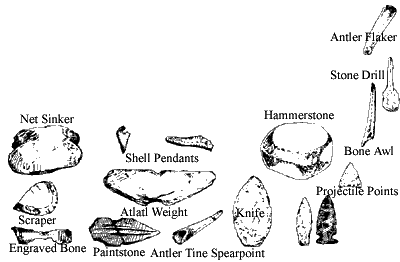
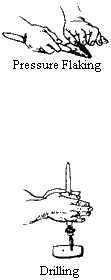
Archaic tools and implements were made of stone, bone and undoubtedly wood and plant fibers. Stone projectile points are the most commonly found
artifacts. They were percussion-chipped from quartz cobbles, and sometimes retouched by pressure flaking. They are believed to have been used on spears
which were thrown with the aid of a spear-throwing stick or atlatl. Thick quartz chips with a steeply beveled working edge served as hide scrapers and
wood-working tools. Thin stone drills were used to pierce wood, bark and soft stone. The drills were probably hafted to a stick and twirled between the palms.
Thin quartz blades were probably mounted in a handle and used as knives. "Bannerstones", believed to be balance weights for spear throwers, are also
occasionally found. Pecked and ground stone wood-working tools were a significant addition to the Indian's tool kit. Grooved and ungrooved axeheads were
introduced during the Archaic stage. These were mounted in handles and used to cut small trees and to shape wood.
The dugout canoe was probably introduced during this stage. Animal hides were pierced and sewn with bone awls or needles. The Indians used pieces of
antler (antler flakers) to pressure flake quartz, and sometimes made spearpoints from antler tips. Some rare engraved shell pendants, worn as
decorative items, probably also date from this stage.
The Transitional Stage
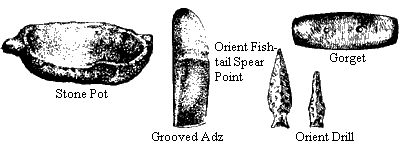
This stage is radiocarbon dated at about 1,000 B.C. though its length is unknown. It is intermediary between the Archaic and the Woodland Stages,
and shares some of the characteristics of both. The Archaic hunting and gathering tradition continues as the basic food getting pattern. Shell fish gathering
seems to have become more important than in previous times as the Indians learned to exploit the food resources of the shoreline more fully. At the same time,
the introduction of baked clay pottery vessels anticipates a dominant characteristic of the succeeding Woodland Stage.
During the Transitional Stage new peoples and ideas were introduced to Long Island from Southern New England and the Pennsylvania-New Jersey region. The
Orient Culture, which may have spread from Southern New England, is the best known Transitional Stage Culture on Long Island.
Orient campsites have been found along tidal bays and streams on the northern and eastern portions of the Island. Their contents reflect a pattern of life
essentially similar to the earlier Archaic sites. However, in contrast to this simple hunting and gathering way of life, the Orient burial sites suggest
elaborate ritualism associated with the disposal of the dead. One might say that the Orient people lavished their wealth on death.
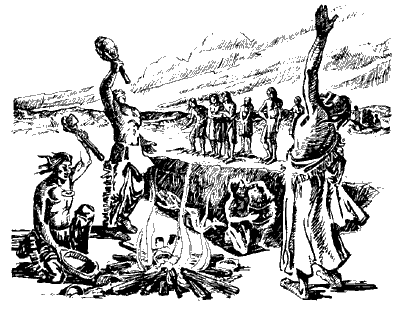
Most striking are the large communal burial pits from hilltops in Eastern Suffolk County. These hand-dug pits were up to thiry feet long by eight feet deep.
At least some of the human bones buried in the pits were first cremated; others may represent bone bundle burials of individuals whose fleshy parts were
first allowed to decay. People may have been buried singly or in groups. A funeral fire seems to have been made at the graveside. Offerings of food,
utensils and perhaps clothing were purposely thrown into the fire. Other artifacts, such as hand-carved stone vessels were broken ("killed"). The
remnants of the fire, including the destroyed artifacts, were placed in the pit, often accompanied by masses of powdered red ocher. Burials in small
individual pits also contained grave offerings. Artifacts buried with the dead included spearpoints for hunting, celts (ungrooved axes) and adzes for
woodworking, quartz and iron pyrite, fire-making kits, cooking vessels, and graphic and hematite paintstones for cosmetic use - in brief, the basic
items necessary for life in the Afterworld. One can imagine that much high drama occurred on these windswept hills of eastern Long Island 3,000 years ago.
The Orient people had small, hand-carved steatite pots, similar in shape to modern casserole dishes. The type of stone used, the technique of manufacture
and the absence of steatite wastage from Long Island sites indicate that these vessels were made in and imported from Southern New England. They may be the
earliest example of trade across the Sound. Other diagnostic Orient artifacts include long fishtail-shaped spearpoints, grooved-back adzes, stone gorgets and
rare bannerstones. Oddly, the scraper is absent from this culture.
The Woodland Stage
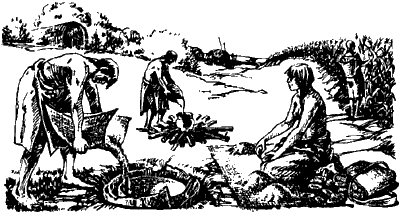
The Woodland Stage may be dated from roughly 1,000 B.C. to the time of European contact. It is characterized, especially after 1,000 A.D., by the flowering
of agriculture, the presence of moderately large permanent or semi-permanent villages, and the extensive use of baked clay pottery vessels. As in earlier
times the sites are situated on tidal bays and streams. A growing population is suggested by fairly numerous sites often several acres in extent.
Shellfish continue to be a major source of food. There is fairly abundant evidence for fishing. Fishbones and scales have been found in refuse-filled pits,
as well as stone netsinkers for use with seine nets, bone fishhooks and occasional antler harpoons.
Agriculture was introduced from the south or west sometime during the Woodland Stage. Wooded areas were cleared for small fields of corn and probably beans
and squash. Agricultural activities are reflected in such artifacts as hoes, shallow stone mortars and pestles. Wild plant foods, including hickory nuts,
were gathered in season. Hunting is belived to have been less important than in earlier times. The bow and arrow was probably introduced to Long Island during the
Woodland Stage. After about 900 A.D. the small, triangular arrowhead is the most important projectile point type. The axe and celt are present, though polished and
ground stone woodworking tools are not especially common. Among the numerous bone tools are awls, eyed needles, antler tines for flaking stone, turtle shell dishes and
beaver incisors used as woodworking tools.
The use of tobacco is attested by straight tubular and elbow pottery pipes. The post-mold patterns of Woodland dwellings are yet to be indetified in the Long Island
sites; oval and cicular wigwams and longhouses (the latter on extreme western Long Island) are assumed from historical information. In contrast to the Orient Culture,
burials were simple and rarely accompanied by grave goods. Individuals were buried in flexed or full length position.

Archaeologists in the eastern United States have traditionally separated the Woodland Stage into three sub-stages: Early, Middle and Late Woodland.
This does not work very well for Long Island, where there is limited data on Early and Middle Woodland. Carlyle Smith, the first archaeologist to
intensively study Woodland material from the Island, identified various pottery types that indicated the presence of two major prehistoric
cultural traditions, Windsor and East River.
Groups of Indians moving from the west or south, brought the Windsor Culture to Connecticut and the coastal New York region about the time of or soon
after the Orient Culture. These people spread out over Long Island. Their pottery vessels tended to be elongated with a pointed base and a straight
rim. Both interior and exterior surfaces were often brushed, or marked with a cord-wrapped paddle. The outer surface of some vessels was stamped, or
impressed with fabric or netting. Decorative designs consisted of lines and bands applied to the lip and rim by stamping (sometimes with scallop shells),
brushing or punctating.
New groups of people, with a new complex of ceramic traits - the East River Culture - appear in greater New York and western Long Island at the beginning
of the Late Woodland sub-stage, about 1,100 A.D. The pottery includes shoulderless vessels with pointed bottoms, but also shouldered pots with high rims
or appliqué collars, a more globular body and a rounded base. The exterior surface below the rim was often cord-marked, or sometimes left plain. The interiors
of the pots were smooth. Designs were stamped or incised on the lip, rim and shoulder. A cord-wrapped stick was often used to make decorative bands around
the upper portion of the vessel. Line-filled triangle motifs were not uncommon.
At some sites, fragments of East River pottery were found above Windsor sherds. In addition, Smith noted that East River pottery was confined to the western
half of Long Island, while Windsor pottery remained in use throughout the rest of the prehistoric period on the eastern portion of the Island. On the
other hand, findings at several sites of both Windsor and East River ceramic traits or characteristics combined in the same vessels tend to suggest that
the relationships between the two cultures may have involved the peaceful mixture of people and ideas rather than territorial occupation and physical
replacement. However this may be, the Windsor tradition may be identified with the Nehantic tribe of coastal Connecticut, and the East River with the
Massapequa tribe on the south shore of Long Island in the 17th century. Generally speaking, the people of the East River culture are believed to have been
the Algonkian-speaking ancestors of the historical Indian tribes of western Long Island.
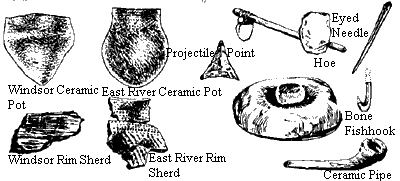
TOP
Referenced from The Nassau County Museum Educational Leaflet 17, written by Ronald Wyatt circa 1972.

